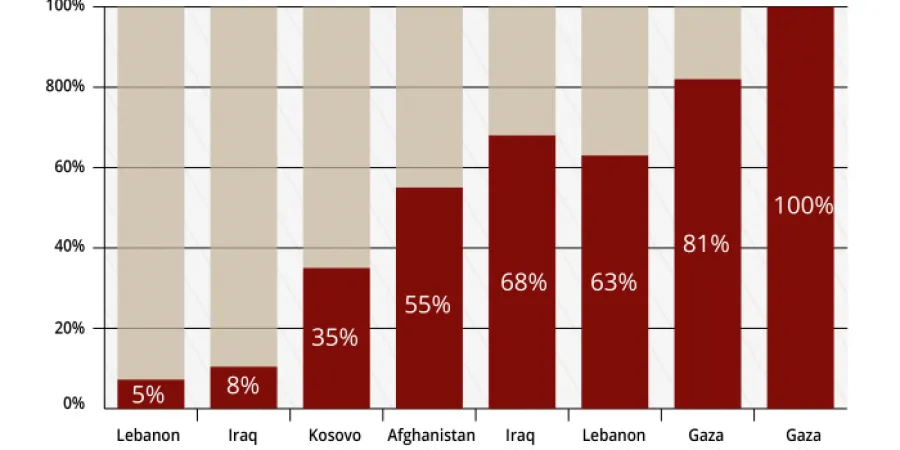Are our munitions in Gaza too precise?
The use of very precise munitions on the battlefield has limitations that need to be considered. The IDF is not on the way to subduing Hamas. An observation by Amir Rapaport
Amir Rapaport
|
19/05/2021
The IDF is breaking records in terms of the level of precision of the munitions it is using in the Gaza Strip. Actually, the war is one of the first in history in which one of the sides is only using precision munitions, with one or two meter accuracy, except for a very small number of cases of the firing of artillery shells into open areas where there is no tangible enemy.
In "Guardian of the Walls", all of the Air Force's munitions are equipped with JDAM GPS-based guidance systems, and these "smart" bombs are considered "dumb" compared to a huge variety of missiles of all sizes and types that can even strike targets through windows. The graph at the top of the article shows the transition that the IDF has undergone regarding the use of guided precision munitions in recent years, until reaching the maximum level.
Without a doubt, the use of extremely precise weapons is a great technological achievement but is also an operational requirement in light of the conditions of warfare against an enemy in a crowded civilian environment. It brought about a drastic decline in the amount of non-combatant casualties (between 100 and 200 during "Guardian of the Walls", as opposed to more than 1,400 as a result of a similar number of attacks during all of "Operation Protective Edge" in 2014)
The relatively small number of noncombatant casualties in the fighting this time gives Israel greater diplomatic breathing room to take action in Gaza (but not a lot). But at the same time, we need to be aware that very precise weapons have an operational disadvantage in that they greatly reduce the pressure on the enemy. When Hamas knows that every bomb has a very precise target, it can simply avoid being in places targeted for attack, or be very deep underground.
That is the reason why in non-urban battlefields it is still important to use "statistical" weapons that cover territory and not only precision guided munitions.
The bottom line is that in the current conditions of the war in Gaza, the most that Israel can hope to achieve is a tie. The only way to move Hamas from its position of relative comfort is by using munitions that strike larger areas, increasing the likelihood of noncombatant casualties, or by a ground operation, with the heavy price involved. As far as it is known, these two options are not under consideration. The IDF has almost achieved everything that it is capable of achieving via very precise attacks from afar.
So under these circumstances, a tie (that will be perceived by the Palestinian side as a victory) is the maximum as far as we are concerned.
The use of very precise munitions on the battlefield has limitations that need to be considered. The IDF is not on the way to subduing Hamas. An observation by Amir Rapaport
The IDF is breaking records in terms of the level of precision of the munitions it is using in the Gaza Strip. Actually, the war is one of the first in history in which one of the sides is only using precision munitions, with one or two meter accuracy, except for a very small number of cases of the firing of artillery shells into open areas where there is no tangible enemy.
In "Guardian of the Walls", all of the Air Force's munitions are equipped with JDAM GPS-based guidance systems, and these "smart" bombs are considered "dumb" compared to a huge variety of missiles of all sizes and types that can even strike targets through windows. The graph at the top of the article shows the transition that the IDF has undergone regarding the use of guided precision munitions in recent years, until reaching the maximum level.
Without a doubt, the use of extremely precise weapons is a great technological achievement but is also an operational requirement in light of the conditions of warfare against an enemy in a crowded civilian environment. It brought about a drastic decline in the amount of non-combatant casualties (between 100 and 200 during "Guardian of the Walls", as opposed to more than 1,400 as a result of a similar number of attacks during all of "Operation Protective Edge" in 2014)
The relatively small number of noncombatant casualties in the fighting this time gives Israel greater diplomatic breathing room to take action in Gaza (but not a lot). But at the same time, we need to be aware that very precise weapons have an operational disadvantage in that they greatly reduce the pressure on the enemy. When Hamas knows that every bomb has a very precise target, it can simply avoid being in places targeted for attack, or be very deep underground.
That is the reason why in non-urban battlefields it is still important to use "statistical" weapons that cover territory and not only precision guided munitions.
The bottom line is that in the current conditions of the war in Gaza, the most that Israel can hope to achieve is a tie. The only way to move Hamas from its position of relative comfort is by using munitions that strike larger areas, increasing the likelihood of noncombatant casualties, or by a ground operation, with the heavy price involved. As far as it is known, these two options are not under consideration. The IDF has almost achieved everything that it is capable of achieving via very precise attacks from afar.
So under these circumstances, a tie (that will be perceived by the Palestinian side as a victory) is the maximum as far as we are concerned.



